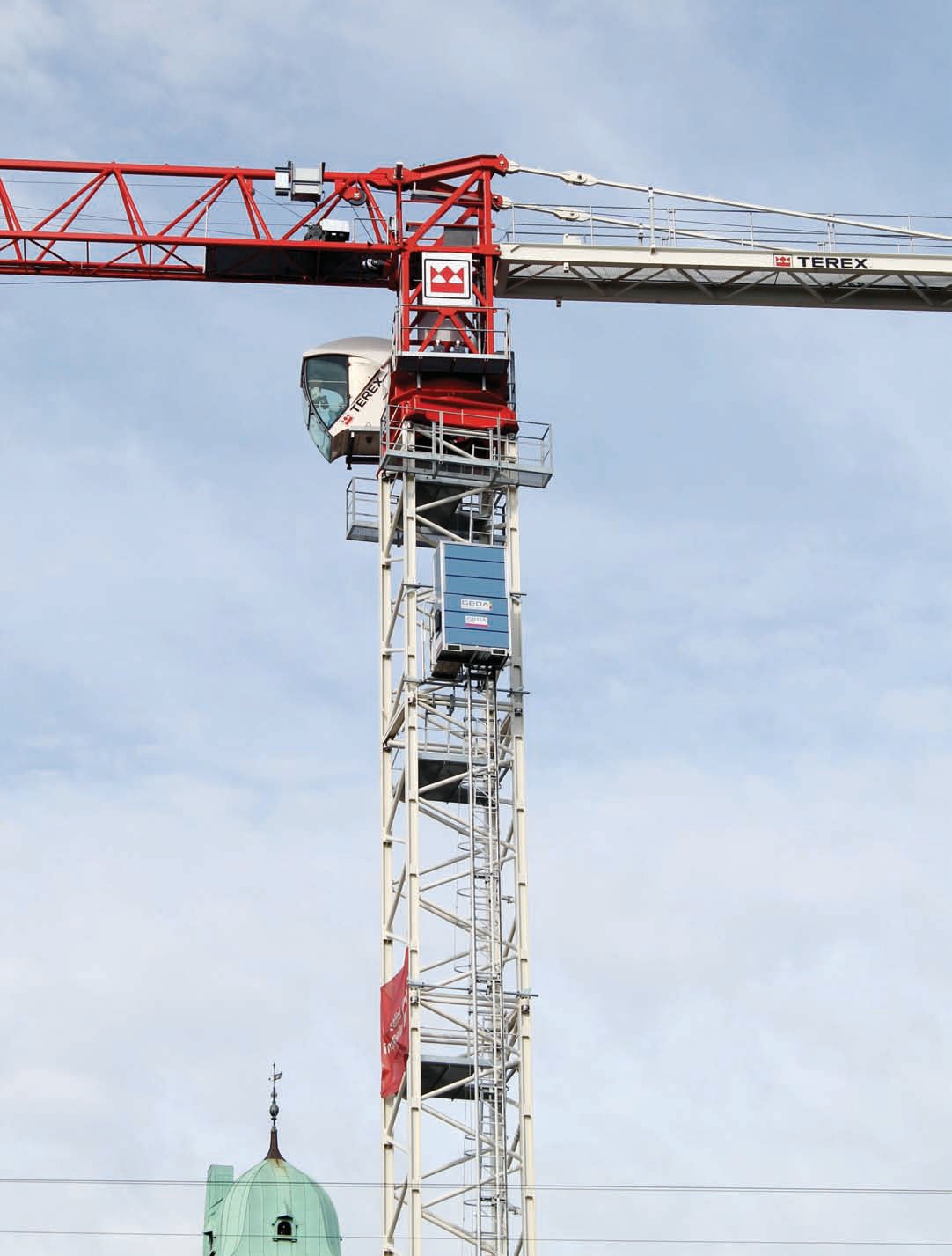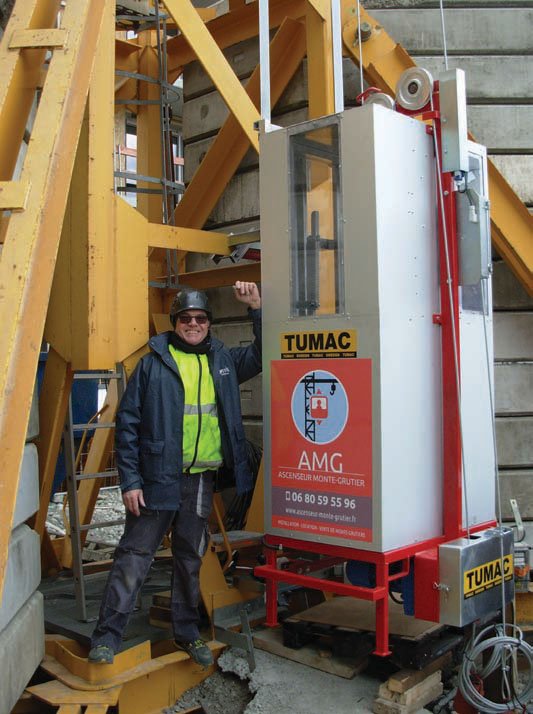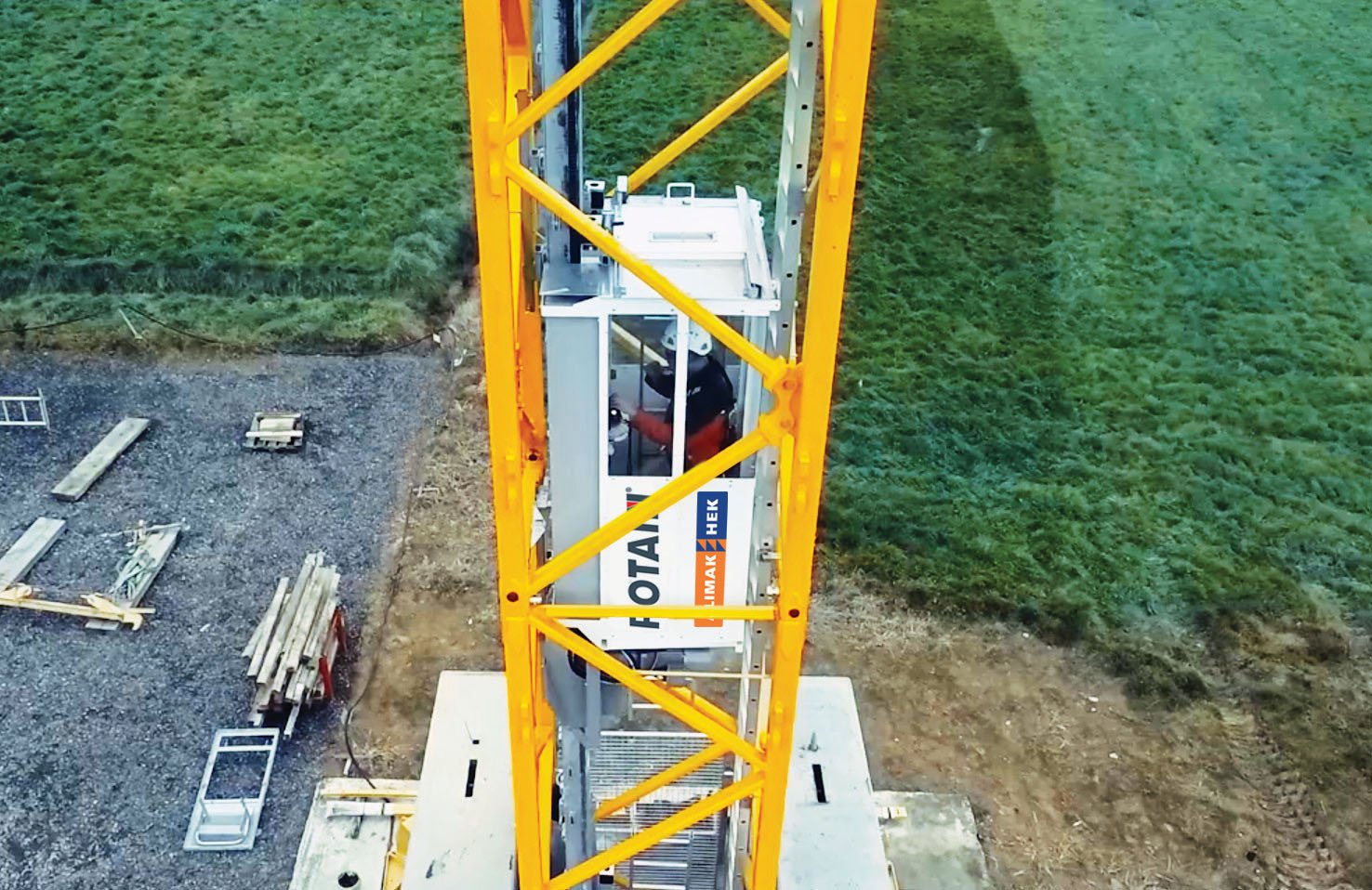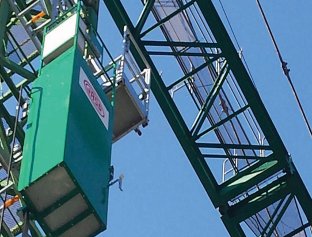An easier commute
19 July 2017While a proposed tightening of French regulations calling for operator lifts has been delayed, manufacturers still expect a gradual increase in demand. Bernadette Ballantyne reports
In October 2016, the French contracting sector was granted a reprieve in the implementation of new regulations regarding the use of operator lifts on tower cranes. The Comité Technique National Des Industries Du Bâtiment et Des Travaux Publics (National Technical Committee of the Building and Public Works Industries) announced that its Recommendation 495, which had already made it a requirement for operator lifts to be installed on cranes over 60m, would be phased in. This meant that the incoming requirement for all tower cranes over 30m to have a motorised lift would be delayed from 1 January 2017, to 1 January 2019. But in acknowledgement of things to come, the committee reduced the operator lift height requirement from 60m to 50m stimulating more investment in operator lifts from French construction firms.
“It put on hold an explosion in demand from the market,” says Thibaut Le Besnerais, global product director for tower cranes at Manitowoc Cranes. “In France 50m is still quite high so most of our customers are so far focussed on the external lift solution. Some of the customers that had the external lift are investigating our internal solution, which is more innovative and represents a higher investment for them.”
Manitowoc has been taking a two-pronged approach to the growing need for operator lifts. Working with Swedish lift manufacturer Alimak Hek, Manitowoc used its sales and marketing network to promote the use of Alimak’s standard existing external tower crane operator elevator, the TCL. At the same time the two companies collaborated on the development of a new product, the CabLIFT, which travels up the inside of the tower crane mast. “It is now available on the most current mast system in our range, the K-Mast,” says Le Besnerais. First developed for the 1.6m and 2.0m masts, a lift for the larger 2.45m mast is in the industrialisation phase. The lift has a 200kg capacity and moves at 24m/minute making cab access five times faster than traditional climbing. One of its biggest advantages, says Le Besnerais, is that during assembly of the cranes, CabLIFT can be used as a platform for technicians supporting their work in erecting the mast.
“It is not only a lift for the crane driver when the crane is erected but it is also for the erection crew, which is better ergonomically and saves time to erect the tower.”
The lift can come preinstalled in the tower mast or can be retrofitted to any K-mast model. In addition, Besnerais says that its design means that no extra storage space is required, as is the case for external lifts. “We believe that being inside the tower the lift is protected by the tower outside because the lift is a fragile piece of equipment so when the lift is inside it is a way to protect shock during transport during loading and unloading.”
Spanish tower crane manufacturer Jaso acquired lift manufacturer Goian in 2016. Jaso area manager Dick Huitema explains that, while the company is now known as Jaso Elevation Systems, it continues to offer lifts for use on all types of tower cranes.
He says, “The GTC25 operator lift offers versatility and a design that is easily adaptable to any tower crane brand available in the market. It is user-friendly, with simple handling, and is easy to install. It can be used both externally and internally.
“Our extensive experience in other fields, such as wind turbines, allows us to adapt the elevator to any tower system in the market, even on 1.20m masts, both inside and outside tower.
“Given the great number of tower cranes, the potential market for operator lifts is enormous, and we believe it will steadily grow. The main markets are obviously France and Sweden, but we receive more and more requests from customers in Asia and Australia
“We are aiming to further adapt the lifts to different markets, along with the wind turbine versions. Our plan is to integrate the elevator as part of the tower crane structure, in components such as the mast and jibs.”
Market ready
French manufacturer XL industries launched its X-UP product in response to the incoming legislation. Director of development Guillaume Décieux says the delay in the recommendation gave contractors and buyers more time to test the products and manufacturers more time to develop them. “In a way, the fact that they postponed the due date helped the customer to get used to how to erect a hoist with the tower crane. For the manufacturers as well there is a learning curve, we will be able to produce more and more machines, serving our customers to be ready for January 2019.”
This learning curve has seen XL modify their own X-UP lift which has been simplified from the original model which had more complex electricals and a faster movement time. By making some changes the lift now transports 200kgs at 18m/ minute and is available at what he considers to be a more sustainable price point. “Companies are really interested in reliable and simple products and that is why we have started with a sophisticated one and redesigned it. The price point was a bit above the expectations of our customers so we made it simpler and now we are fully in the range of what our customers expect,” he says.
Important features of the X-UP product are that its connection ties to the tower mast are both universal, allowing it to be fitted to any crane model, and flexible so that it doesn’t affect the stiffness of the mast. “We design our ties to be really flexible. A tower crane bends and there is a torque as well when the jib turns, so you need to have really flexible ties otherwise you break everything,” says Décieux.
Nordic lead
Although the most recent development in requirements for operator lifts in tower cranes is in the French market, the trend began in Northern Europe. “In Sweden we have had rules since 1974 when there was a government rule that from 25m of height of the tower crane there must be a hoist for the crane driver,” explains Benny Ask, chief executive of Tumac. “With Skanska, we made a special installation, an open ropedriven platform that was accepted by health and safety. We sold several hundred in the first year. Hoists from the 70s and 80s are still out working in Sweden.”
Today Tumac’s rope hoists have been modified and updated. The lift now has a 200kg capacity on a 0.75 x 1.0m platform with a 2.2KW engine moving operators at 17m/minute.
Ask says that despite the developments in Scandinavia and France, the rest of Europe has been less interested in legislating for crane lifts. “I think the main question is that the crane driver is paid to climb so if he has a hoist he won’t be paid as well. If it is a very high tower crane it is very good pay. Crane owners don’t want extra machines if they don’t have to, so no one is interested in the lifts unless there is legislation.”
Manufacturers of cranes say that installing a lift can add 10 to 15% on to the capital cost of a crane and is clearly a reason for resisting regulatory developments. However, Tumac’s Ask says it is only a matter of time before the trend spreads. “I expect that this [regulation] will happen in every country. But it will take some more time in some countries, and be faster in others. It has taken a very long time in France but now we have orders for several hoists. So this year everything has started.”
Ask points to markets such as the UK as being more likely than others to move forward with such legislation. Currently there is no requirement for crane operator lifts in the UK, but under the Lifting Operation and Lifting Equipment Regulations (LOLER), users of tower cranes must have an emergency rescue plan in place. If the risk assessment shows that the time taken to affect this rescue plan is inappropriate due to the height of the mast, then users should consider specifying a lift. However, discussion is ongoing within the industry about what constitutes an “inappropriate time” for rescue. Typically the rescue plan for a tall tower crane on a construction site would use the lifts already contained in the building that it is likely to be tied to with only the last few mast sections requiring any climbing. The ongoing uncertainty in the country around Brexit makes it unlikely that the UK’s Health and Safety Executive would pursue any new legislation at this point in time.
The need for swift rescue of sick or injured tower crane operators is something Jaso has considered. Huitema explains that, as well as looking at new ways to integrate the elevator into tower cranes, Jaso is also looking at how it could be used in an ad hoc way as a rescue system for crane operators.
In Australia too there is no requirement for tower cranes to be equipped with operator hoists when free standing a particular height. Chief Executive of the Crane Industry Council of Australia, Brandon Hitch says that there is an agreement in the state of Victoria between builders, trade unions and crane owners to fit hoists on cranes with a free-standing height of 30m or more. “Many cranes are initially installed at 30m without a hoist and then once a building tie is installed the crane is climbed or jumped to a height greater than 30m,” he explains. “With the building tie a walking platform is used to keep the height that the operator climbs less than 30m.”
However, he doesn’t anticipate this requirement spreading to other states.
Inside job
Despite the lack of requirement for tower crane operator lifts in Germany, Liebherr has already developed an advanced rope and cable free internal mast elevator. Like other manufacturers it has a 200kg capacity but slightly higher lifting speed at 25m/minute and can move operators up to 300m.
The LiUP rails are manufactured to coordinate with the length of the tower mast sections and can be either integrated with a new crane or retrofitted to an existing mast. The system is erected, dismantled, and stored with the crane so like the CabLIFT requires no extra storage. Interestingly the elevator is powered using a lithium ion battery which can recover 40% of expended energy on the lift descent due to its innovative drive technology. It can also be operated using the crane’s power supply. The safety features of the LiUP include three limit switches and a clasp break which reacts if the elevator travels too quickly.
German hoist manufacturer GEDA also makes crane elevators but like other non-crane companies these are external. The GEDA 2 PK is a rack and pinion hoist with aluminium ladder segments. Like XL and Tumac the system is universal. The standard version is for heights up to 150m but bespoke systems can be produced for higher lifting. Again the lift capacity is 200kg and its lift speed is 200m/minute. GEDA says that the elevator is easy to assemble and points to a major project in Cádiz, Spain, where it was used during the construction of La Pepa road bridge, connecting Cadiz to Puerto Real. A Comansa crane, fitted with a GEDA 2PK lift was installed on one of the 180m high bridge pylons for the 3km cable stayed crossing.
GEDA points to major benefits in using a lift system. First is all about safety. An unconscious or ill crane operator can be reached in minutes in case of emergency and risky climbing requirements are minimised. Furthermore the accelerated process means construction companies save time on the job.
GEDA says an additional benefit of its 2 PK system is its easy assembly. Once the base unit is assembled, the 22kg aluminium ladder sections are installed through the open cabin roof, and assembled using the company’s patented quick release connections.
Special rail anchoring provides tension-free attachment to the crane mast. In addition to the main control mechanism in the cage, the GEDA 2 PK has an additional steering mechanism in the ground station or as an option at the upper exit point. At high wind speeds, the crane driver can also guide the cage from the upper landing gates downwards and then park the hoist there for the duration of the work. Then the crane does not have to withstand any additional wind forces in the upper area.
For now at least external lifts remain the most common choice for tower crane owners that require an operator hoist, and although Scandinavia and France are leading the world in terms of legislation there are pockets worldwide where crane or project owners are shifting towards the use of operator hoists. The result has been some impressive technological investments from both elevator and crane companies alike which mean that when the regulatory picture changes, the industry will be ready.
 The GEDA 2 PK is a rack and pinion hoist with aluminium ladder segments suitable for use with any crane type.
The GEDA 2 PK is a rack and pinion hoist with aluminium ladder segments suitable for use with any crane type.
 The Tumac lift has a 200kg capacity on a 0.75 x 1.0m platform with a 2.2KW
engine moving operators at 17m/minute.
The Tumac lift has a 200kg capacity on a 0.75 x 1.0m platform with a 2.2KW
engine moving operators at 17m/minute.

